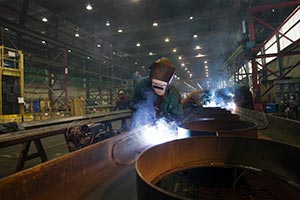Economy Grows More Than Forecast in Second Quarter

The economy grew more than previously estimated in the second quarter on bigger gains in consumer and business spending that show the U.S. expansion got back on track. A surge in inventories also signals such strong growth will be difficult to sustain in the short run.
Gross domestic product, the value of all goods and services produced, rose at a 3.7% annualized rate, exceeding all estimates of economists surveyed by Bloomberg and up from the 2.3% the Commerce Department reported last month, figures showed Aug. 27.
American households, bolstered by gains in employment, rising home prices and cheaper fuel costs, probably will continue to spur the economy in the second half of the year. At the same time, a record surge in stockpiles represents another headwind for manufacturers already contending with a rising dollar and slumping emerging markets that have hurt exports.
“The economy is looking solid,” said Michael Feroli, chief economist at JPMorgan Chase & Co. in New York, who projected 3.4% GDP growth. “There’s a pretty broad-based pickup in domestic demand.”
The report comes as Federal Reserve policymakers debate whether growth is strong enough to withstand the first increase in the benchmark interest rate since 2006. While the job market has made strides since the recession ended, inflation remains well short of the central bank’s goal. Additionally, the global plunge in stocks could argue for a delay.
The median forecast of 79 economists surveyed by Bloomberg called for a 3.2% gain in GDP, or the value of all goods and services produced. Forecasts ranged from 2.3% to 3.6%.
A report Aug. 27 from the Labor Department showed fewer Americans applied for unemployment insurance benefits last week. Jobless claims declined by 6,000 to 271,000 in the week ended Aug. 22. That’s just above a four-decade low of 255,000 reached in mid-July.
The latest GDP estimate is the second of three for the quarter, with the third release scheduled for late September when more information becomes available.
The economy grew at a 0.6% pace from January through March, restrained by harsh winter weather, a labor dispute at West Coast ports and a slump in energy-industry investment after oil prices dropped.
The report also offered a first look at corporate earnings. Before-tax profits rose 2.4% in the second quarter after dropping 5.8% in the prior period. From the same time last year, profits were down 0.5%.
The biggest driver of the upward revision for second-quarter GDP was a bigger gain in business investment, which included stronger readings on construction, research and development and inventories. The 8.6% advance in spending on intellectual property was the largest since the last quarter of 2007.
The surge in stockpiles is a double-edge sword because, while it boosted growth last quarter, companies probably will need to trim the amount of goods on hand from July through September, leading to cuts in production that will restrain GDP.
Stockpiles climbed at a $121.1 billion annualized pace compared with an initially estimated $110 billion, and added 0.2 percentage point to economic growth.
After the first quarter’s $112.8 billion increase, it marked the biggest back-to-back gain in inventories since records began in 1947.
“It does raise the risk that at some point later in the year we might see a little bit of pullback in inventories” as companies cut production, Sam Coffin, an economist at UBS Securities in New York, said before the report.
Household consumption, which accounts for almost 70% of the economy, grew at a 3.1% annualized rate, revised from an initial estimate of 2.9% and following a 1.8% advance from January through March.
Gains in consumers’ purchasing power cooled last quarter, with disposable income adjusted for inflation rising at a 1.3% rate from April through June after a 3.9% gain in the first quarter. The saving rate decreased to 4.8% from 5.2% in the first three months of the year.
Still, “the U.S. consumer is looking healthy,” Jennifer Lee, a senior economist in Toronto for BMO Capital Markets, said before the report. “Employment is strong. The housing recovery is going to continue.”
The report also included revisions to first-quarter personal income. Wages and salaries rose by $49.8 billion, revised up by $5.6 billion. They climbed by $47.7 billion in the second quarter.
Gross domestic income, which reflects all the money earned by consumers, businesses and government agencies, climbed at a 0.6% annualized rate in the second quarter after a 0.4% advance, the report showed.
Government spending also was a standout last quarter, increasing at a 2.6% pace, the most in five years. State and local outlays increased at the fastest rate since late 2001.
Fed policymakers, considering raising the benchmark interest rate for the first time since 2006, are monitoring the global stock market turmoil.
“From my perspective, at this moment, the decision to begin the normalization process at the September FOMC meeting seems less compelling to me than it was a few weeks ago,” New York Federal Reserve President William Dudley said Aug. 26, cautioning it is important not to overreact to short-term developments. He also described the economy as “performing quite well.”
Dudley said one important way that market volatility could influence the U.S. economy was through the so-called wealth effect, in the event that stock market losses lead Americans to cut back their spending. Another key channel is what happens to inflation, which has been running below the Fed’s 2% target for more than three years.

